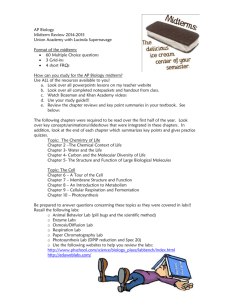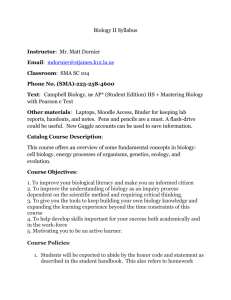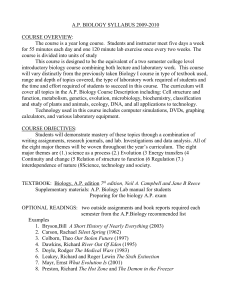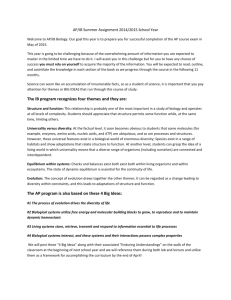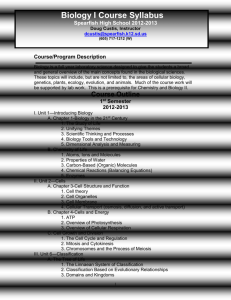AP Biology Summer 2007
advertisement
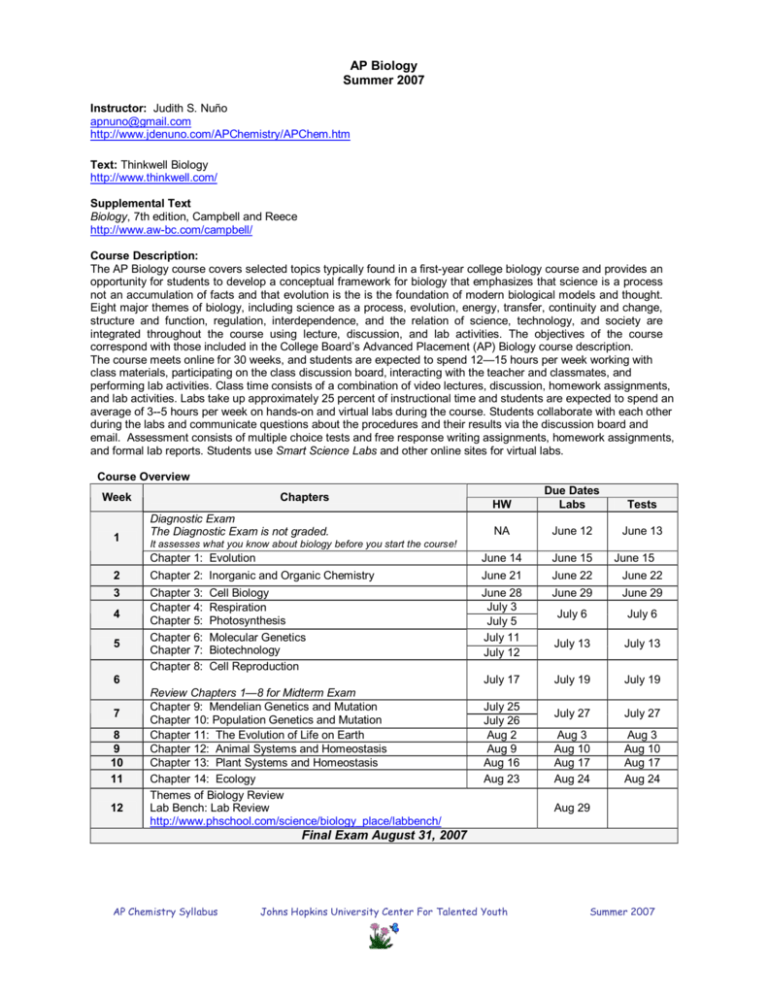
AP Biology Summer 2007 Instructor: Judith S. Nuño apnuno@gmail.com http://www.jdenuno.com/APChemistry/APChem.htm Text: Thinkwell Biology http://www.thinkwell.com/ Supplemental Text Biology, 7th edition, Campbell and Reece http://www.aw­bc.com/campbell/ Course Description: The AP Biology course covers selected topics typically found in a first­year college biology course and provides an opportunity for students to develop a conceptual framework for biology that emphasizes that science is a process not an accumulation of facts and that evolution is the is the foundation of modern biological models and thought. Eight major themes of biology, including science as a process, evolution, energy, transfer, continuity and change, structure and function, regulation, interdependence, and the relation of science, technology, and society are integrated throughout the course using lecture, discussion, and lab activities. The objectives of the course correspond with those included in the College Board’s Advanced Placement (AP) Biology course description. The course meets online for 30 weeks, and students are expected to spend 12—15 hours per week working with class materials, participating on the class discussion board, interacting with the teacher and classmates, and performing lab activities. Class time consists of a combination of video lectures, discussion, homework assignments, and lab activities. Labs take up approximately 25 percent of instructional time and students are expected to spend an average of 3­­5 hours per week on hands­on and virtual labs during the course. Students collaborate with each other during the labs and communicate questions about the procedures and their results via the discussion board and email. Assessment consists of multiple choice tests and free response writing assignments, homework assignments, and formal lab reports. Students use Smart Science Labs and other online sites for virtual labs. Course Overview HW Due Dates Labs Tests NA June 12 June 13 Chapter 1: Evolution June 14 June 15 2 Chapter 2: Inorganic and Organic Chemistry June 21 June 22 June 22 3 Chapter 3: Cell Biology Chapter 4: Respiration Chapter 5: Photosynthesis Chapter 6: Molecular Genetics Chapter 7: Biotechnology Chapter 8: Cell Reproduction June 28 July 3 July 5 July 11 July 12 June 29 June 29 July 6 July 6 July 13 July 13 July 17 July 19 July 19 July 27 July 27 Aug 3 Aug 10 Aug 17 Aug 24 Aug 3 Aug 10 Aug 17 Aug 24 Week 1 4 5 Chapters Diagnostic Exam The Diagnostic Exam is not graded. It assesses what you know about biology before you start the course! 6 7 8 9 10 11 12 Review Chapters 1—8 for Midterm Exam Chapter 9: Mendelian Genetics and Mutation Chapter 10: Population Genetics and Mutation Chapter 11: The Evolution of Life on Earth Chapter 12: Animal Systems and Homeostasis Chapter 13: Plant Systems and Homeostasis Chapter 14: Ecology Themes of Biology Review Lab Bench: Lab Review http://www.phschool.com/science/biology_place/labbench/ July 25 July 26 Aug 2 Aug 9 Aug 16 Aug 23 June 15 Aug 29 Final Exam August 31, 2007 AP Chemistry Syllabus Johns Hopkins University Center For Talented Youth Summer 2007 Detailed Course Schedule Week Chapters Diagnostic Exam The Diagnostic Exam is not graded. It assesses what you know about biology before you start the course! Chapter 1: Evolution 1.1 Unity and Diversity of Life on Earth 1.2 Early Perspectives in Science 1.3 An Introduction to Evolution 1.4 Evolution: The Theory of Natural Selection 1.5 Fossils and Evolution 1.6 Human Evolution 1.7 Evidence for Evolution 1.8 Species Concepts 1.9 Examples of Artificial and Natural Selection 1.10 The Origin of Life 1.11 Classifying Life 1 Scientific Method Lab and Graphing and Data Analysis Lab Chapter 1 Test Chapter 2: Inorganic and Organic Chemistry 2.1 An Introduction to Atoms 2.2 Atoms and Bonding 2.3 Properties of Water 2.4 Carbon Chemistry 2.5 Carbohydrates 2.6 Lipids and Nucleic Acids 2.7 Proteins 2.8 Enzymes 2.9 Enzyme Action 2 (AP LAB 1) Enzyme Catalysis Lab Chapter 2 Test Chapter 3: Cell Biology 3.1 An Introduction to Cell Biology 3.2 Membrane­Bound Organelles 3.3 The Cytoskeleton 3.4 The Plasma Membrane 3.5 Cell Transport 3.6 Tools for Cell Biology 3.7 The Evolution of Metabolic Functions 3 (AP LAB 2) Diffusion—Osmosis Lab Chapter 3 Test Chapter 4: Respiration 4.1 An Introduction to Respiration 4.2 Glycolysis and Fermentation 4.3 Aerobic Respiration 4.4 The Electron Transport Chain & Oxidative Phosphorylation 4 (AP LAB 5) Respiration Lab Chapter 5: Photosynthesis 5.1 Discovering Photosynthesis 5.2 Adaptations for Photosynthesis 5.3 The Light Reactions 5.4 The Dark Reactions 5.5 Photorespiration (AP LAB 4) Photosynthesis Lab and Plant Pigments Lab Chapters 4—5 Test AP Chemistry Syllabus Johns Hopkins University Center For Talented Youth Summer 2007 Week Chapters Chapter 6: Molecular Genetics 6.1 Discovering DNA 6.2 DNA Structure Revealed 6.3 Introduction to DNA Replication 6.4 Events of DNA Replication 6.5 Transcription 6.6 Translation 6.7 Protein Synthesis Review 6.8 The lac Operon 6.9 Eukaryotic Genomic Organization 6.10 Controlling Protein Synthesis in Eukaryotes 5 Chapter 7: Biotechnology 7.1 Plasmids and Gene Cloning 7.2 Techniques in Biotechnology 7.3 More Techniques in Biotechnology 7.4 Human Genome Project 7.5 Bioethics (AP LAB 6) Molecular Genetics Lab Chapters 6—7 Test Chapter 8: Cell Reproduction 8.1 An Introduction to the Cell Cycle and Mitosis 8.2 Regulating Mitosis 8.3 Meiosis 8.4 Understanding Meiosis 6 (AP LAB 3) Mitosis/Meiosis Lab Midterm Exam: Chapters 1­­8 Chapter 9: Mendelian Genetics and Mutation 9.1 Gregor Mendel 9.2 The Laws of Mendelian Inheritance 9.3 Segregation and Independent Assortment 9.4 Laws of Probability 9.5 Genetic Dominance 9.6 Epistasis 9.7 Inheritance Patterns 9.8 Linked Genes and Genetic Mapping 9.9 Sex Linkage and Pedigree Charts 9.10 Problems in Heredity 9.11 Genetic Mutation 7 (AP LAB 7) Genetics of Organisms Labs Chapter 10: Population Genetics and Mutation 10.1 The Hardy­Weinberg Theory 10.2 Departing From Hardy­Weinberg Equilibrium 10.3 Variations in Populations and Modes of Selection 10.4 Speciation 10.5 Evolution (AP LAB 8) Population Genetics Lab and/or Natural Selection Lab Chapters 9—10 Test Chapter 11: The Evolution of Life on Earth 11.1 Classifying Earth's Organisms 11.2 Domain Archaea 11.3 Domain Bacteria 11.4 Protists and the Origin of the Eukaryota 11.5 The Colonization of Land by Plants 11.6 Alternation of Generations: Mosses, Ferns, and Gymnosperms 11.7 Angiosperms 11.8 Fungi 11.9 Evolution of the Animal Kingdom 11.10 Invertebrates 11.11 Deuterostomes 11.12 Chordate Development 11.13 The Cellular and Molecular Basis of Development 11.14 Viruses and Prions 8 (AP LAB 11) Animal Behavior Lab Chapter 11 Test AP Chemistry Syllabus Johns Hopkins University Center For Talented Youth Summer 2007 Week Chapters Chapter 12: Animal Systems and Homeostasis 12.1 Introduction to Animal Systems and Homeostasis 12.2 The Digestive System 12.3 Gas Exchange and Transport Systems 12.4 Circulation 12.5 Blood Pressure and Clotting 12.6 Human Excretion 12.7 The Immune System: An Introduction 12.8 The Immune System Continued 12.9 HIV and the Immune System 12.10 The Endocrine System 12.11 The Ovarian and Uterine Cycles 12.12 The Nervous System 12.13 The Nerve Impulse 12.14 Motor Mechanisms 12.15 Sensory Reception 9 (AP LAB 10) Cardiac Physiology Lab Chapter 12 Test Chapter 13: Plant Systems and Homeostasis 13.1 Plant Development 13.2 Plant Hormones 13.3 Photoperiodism 13.4 Plant Transport 10 (AP LAB 9) Transpiration Lab and/or Seed Germination Chapter 13 Test Chapter 14: Ecology 14.1 Introduction to Ecology 14.2 Biomes 14.3 Animal Behavior 14.4 Competitive and Courtship Behaviors 14.5 Population Ecology 14.6 Community Ecology: Interspecific Interactions 14.7 Community Ecology: Succession 14.8 Community Ecology: Species Diversity 14.9 Energy Flow in an Ecosystem 14.10 Chemical Cycling in the Ecosystem 14.11 Human Effect on the Ecosystem and Environmental Concerns 14.12 Science and Society; Bioethics 11 (AP LAB 12) Dissolved Oxygen Lab Chapter 14 Test Themes of Biology Review Lab Bench: Lab Review http://www.phschool.com/science/biology_place/labbench/index.html 12 Lab 1: Diffusion and Osmosis Lab 2: Enzyme Catalysis Lab 3: Mitosis and Meiosis Lab 4: Plant Pigments & Photosynthesis Lab 5: Cell Respiration Lab 6: Molecular Biology Lab 7: Genetics of Organisms Lab 8: Population Genetics Lab 9: Transpiration Lab 10: Circulatory Physiology Lab 11: Animal Behavior Lab 12: Dissolved Oxygen Final Exam AP Chemistry Syllabus Johns Hopkins University Center For Talented Youth Summer 2007 Grading Information Activity Description of Activity The AP Exam consists of both multiple choice questions and free response questions. Free response questions generally have several parts and require that you integrate information from various areas of biology. Unit Tests Homework Lab Participation Thinkwell Exercises Midterm Exam Final Exam The weekly tests will consist of multiple choice and free response questions from the chapters indicated in the Course Overview. There will be 10 unit tests. Each test has a value of 50 points. Responses to the multiple­choice and free response questions will be submitted online in the Thinkwell classroom. There will be 14 problem sets that are in multiple­choice format, similar to those in the Thinkwell exercises and to those that will be on the unit tests. Homework assignments have a value of 10 points. Instructions for Hands­on and Virtual Lab activities will be available in the Thinkwell classroom and online at Smart Science Labs. Specific instructions on how to complete and submit lab reports will be posted in the Thinkwell Classroom. Students should expect to spend 3—5 hours per week on lab activities! Formal lab reports are required for all labs. Students may have a choice of labs to complete each week. Labs have a value of 25 points. Discussing concepts and ideas is a very important part of learning any subject but it is particularly important in an online environment. Students are required to post questions and responses in the discussion board for the different chapters. The questions and responses will focus on integrating knowledge about science as a process, evolution, energy transfer, continuity, and change, relationship of structure and function, regulation, interdependence, and science­technology­society. Participation has a value of 5 points. Each section of the textbook has 4­12 questions associated with it. These questions are scored automatically and can be repeated up to three times. Although these exercises are not required to complete the course and not graded for the course grade, it is highly recommended that students work through them for extra practice. This exam will consist of 40 multiple choice questions from chapters 1—8 and 2 free response questions. The midterm exam has a value of 100 points This exam will consist of 80 multiple­choice questions and 4 free response questions. This format and questions will be similar to those found on the AP Biology exam. The final exam has a value of 200 points Grading Scale Letter A A­ B+ B B­ C+ C C­ D F Percent 93 90 87 83 80 77 73 70 60 BELOW 60 AP Chemistry Syllabus Johns Hopkins University Center For Talented Youth Summer 2007

